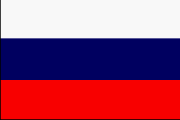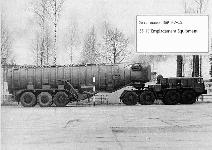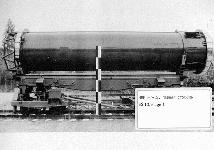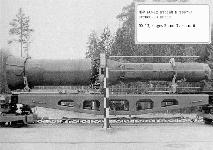





The RT-2 is a three-stage missile with sequentially arranged stages and a single reentry vehicle. According to Western estimates, the missile was capable of delivering a 1200 lb reentry vehicle to a maximum operational range of 5500 nm with a CEP in the range of 0.7 to 1.0 nm. The three sustainer stages, using solid-propellant motors, were connected by trellised trusses. Four trellised aerodynamic stabilizers were used to stabilize the missile during the active trajectory leg. The flight control was implemented with the help of four split nozzles. With a nose cone of 500 kg it had a maximum range of 10,000-12,000 km, which was reduced to 4,000-5,000 km when employing a heavier nose cone of 1,400 kg. The guidance/control system incorporated a gyro-stabilized platform with floating gyros and pendulous accelerometers.
Three variants of the SS-13 reentry vehicle have been identified. The Mod 1 variant had a ballistic coefficient of approximately 300 lb per sq ft and a CEP assessed in the West of about 1.0 nm. The Mod 2 has a ballistic coefficient of approximately 730 lb per sq ft and a CEP assessed at about 0.7 nm. Both had a yield in the range 0.6 to 1.5 MT, according to Western sources.
The system was deployed in hardened and dispersed unmanned silos. Silo and launch control hardness was estimated by Western sources at 1300 psi overpressure. Because of the heavy weight of the missile it was transported in parts. The first stage was separated from the second and third stage. The assembly of a missile was directly carried out in the silo. The silo door was sealed and the ensuing special climate conditions in the silo guaranteed an extended storage of the solid-propellant. The missile launch was effected through a new technique that was essentially the breadboard of a subsequently used method called "mortar launch". Water was poured into the bottom of the launch canister, while in the tail unit of the missile a shroud provided for isolation. During the ignition of the first sustainer stage the steam that formed underneath the missile popped the missile out of the silo. The readiness for missile firing was 3-5 minutes.
A railway based version of the RT-2 missile was also studied, but the project never advanced beyond the preliminary design phase.
The task of developing a solid-fuel missiles with a range of 10-12 thousand kilometers was approved by the ministerial Council on 20 November 1959, with Korolev's OKB-1 in charge of carrying out the design.
The development of this ICBM was scheduled to be conducted in two separate phases. The first phase provided for the development of a missile designated as RT-1 with a range of 2500-3000 kms using solid fuel. The RT-1 missile was developed and underwent flight test but was not deployed. With a launch weight of 35.5 T and a payload of 800 kg it had a limited range of only 2,000 km, the same as the R-12.
The preliminary design of the RT-2 missile was finished in 1963. The flight tests were conducted in two phases from February 1966 through November 1968. It was first detected by Western intelligence during a 1,050 nm short-range flight test on 26 February 1966. During the first phase of tests, from February through July 1966, seven successful launches from the test site in Kapustin Yar were carried out. The missiles were launched from adapted silos and the nose cones were successfully deployed. During the second test phase between 03 October 1966 and 04 November 4, a total of 16 successful missile firings out of a total of 25 launches took place on the test site in Plesetsk. A total of 21 of the 25 missiles were tested on an intermediate range basis with the nose cone falling on a training site on Kamchatka and four were tested on maximum range with the nose cone falling into the Pacific Ocean.
On 18 December 1968 deployment of the RT-2 missile began. According to Western estimates, the initial operational capability was probably achieved in 1969. Maximum deployment was reached in 1972. The missile deployment areas of missiles RT-2 were organized in area of Yoshkar Ola. Despite the hardness of the silos and the relative simplicity of operation, the operational capabilities of the RT-2 were limited due to a small throw-weight and the short operational lifetime of the solid-propellant motors. These characteristics limited the deployment to only 60 RT-2 missiles.
In 1968 the development of a modernized version with a sophisticated control system and countermeasures for overcoming an ABM system was undertaken by KB Arsenal. The missile received the designation RT-2P. The flight tests RT-2P were conducted from December 1969 tthrough January 1972, and on 28 December 1972 the first missiles were deployed.
In 1974 the RT-2M variant was deployed. This system was developed by Nadiradize, which finally took over the program in 1973.
The expected service time of the RT-2 and RT-2Ps were estimated to be 10 years. Periodic static tests of motors on firing stands which were carried out after extended storage allowed an extension of the time the missiles could remain in service. The missiles remained in service for more than twenty years, and were phased out by the middle of 1996. Some have been replaced by the "Topol" missile.
Specifications | ||||
|
Mod-1 |
Mod-2 |
Mod-3 |
||
|
DIA |
SS-13 |
SS-13 |
SS-13 |
|
|
NATO |
Savage |
Savage |
Savage |
|
|
Bilateral |
RS-12 |
RS-12 |
RS-12 |
|
|
Service |
RT-2 |
RT-2P |
RT-2M |
|
|
OKB/Industry |
8K98 |
8K98P |
8K98M |
|
|
Design Bureau |
OKB-1, Acad. S. P. Korolev |
OKB-1 Acad. S. P. Korolev & TsKB-7, Arsenal, Acad. A. D. Nadiradize which finally took over in 1973 |
TsKB-7, Arsenal, Acad. A. D. Nadiradize which finally took over in 1973 |
|
|
Approved |
04/04/1961 |
12/18/1968 |
||
|
Years of R&D |
1958-68 |
1969-72 |
||
|
Engineering and Testing |
1966-68 |
1969-72 |
||
|
First Flight Test |
2/26/1966 IRBM & 11/4/1966 ICBM |
01/16/1970 |
||
|
IOC |
7-1-1969 |
1972 |
||
|
Deployment Date |
12/18/1968 |
12/28/1972 |
1974 |
|
|
Type of Warhead |
Single |
Single |
Single |
|
|
Warheads |
1 |
1 |
1 |
|
|
Yield (Mt) |
0.75-1.0 |
0.75-1.65 |
.466-.467 |
|
|
Yield (Mt) |
0.6-1.5 |
0.6-1.5 |
||
|
Payload (t) |
0.545 |
0.6-1.4 |
0.5- 1.0 |
|
|
Total length (m) |
21.27 |
21.265 |
21.13 |
|
|
Total length w/o warhead (m) |
19.7 |
19.66 ? 19.7 |
19.8 |
|
|
Missile Diameter (m) |
1.95 |
1.95, |
2.0 |
|
|
Diameter of Stabilizers (m) |
3.618 |
3.618 |
3.618 |
|
|
Launch Weight (t) |
46.1 ? 51 |
51.6 ? 51.9 |
50 |
|
|
Fuel Weight (t) |
43.9 |
43.9 |
||
|
Range (km) |
9,400 ? 9,500 |
10,000-10,200 |
10,000 |
|
|
CEP (m) (Russian Sources) |
1,800 - 2,000 |
1,300 ?1,500 |
1,500 - 1,800 |
|
|
CEP (m) (Western Sources) |
1,850 - 2,000 |
1,500 ?1800 |
||
|
Number of Stages |
3 |
|
Canister length (m) |
N/A |
|
Canister length w/o front meters (m) |
N/A |
|
Canister diameter (m) |
N/A |
|
Booster guidance system |
Inertial, autonomous |
|
1st stage |
2nd stage |
3rd stage |
||||||||
|
Mod1 |
Mod2 |
Mod3 |
Mod1 |
Mod2 |
Mod3 |
Mod1 |
Mod2 |
Mod3 |
||
|
Length (m) |
8.7 |
9.2 |
9.2-9.5 |
4.74 |
5.08 |
4.8 |
3.827 |
5.45 |
4.5-4.7 |
|
|
Body diameter (m) |
1.84 |
1.84 |
1.9 |
1.49 |
1.49 |
1.5 |
0.98-1.06 |
0.98-1.06 |
1.0 |
|
|
Fueled weight (t) |
34.55 |
34.55 |
35 |
9.6 |
11.28 |
3,5 |
4.64 |
? |
||
|
Dry weight (t) |
30.67-30.8 |
30.8 |
9.78 |
3.6 |
? |
|||||
|
Solid Motor Designation |
15D23 |
15D23P |
15D24 |
15D24P1 |
15D25 |
15D94 |
15D31/94 |
|||
|
Propellants- Solid Propellants |
Solid |
Solid |
Solid |
Solid |
Solid |
Solid |
Solid |
Solid |
Solid |
|
|
Burning time |
75.37 |
75.37 |
59 |
60.6 |
45-46 |
49 |
||||
|
Solid Motor Thrust Sea Level/Vacuum (Tonnes) |
91 |
100 |
44 |
44.6 - 44.77 |
22 |
18 |
||||
|
Specific Impulse (sec) |
237 / 263 |
269.5 |
271 |
|||||||
|
Basing Mode |
Silo |
|
Hardness |
1290 psi/LCC at 1430 psi |
|
Launching Mode |
Hot |
|
Deployed boosters |
40 |
|
Test Boosters |
8 |
|
Warheads Deployed |
40 |
|
Training Launchers |
2 |
|
Space Booster Variant |
No |
Deployment Sites
|
START |
Locale US-Designation |
|
Yoshkar Ola |
Yoshkar Ola |

SS-13/RS-12 Emplacement Equipment |
 |
 |
